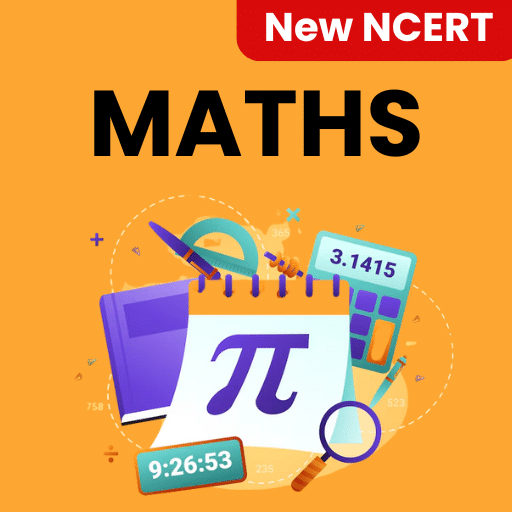Unit Test Questions and Solution: Number Play | Mathematics for Class 6 PDF Download
Time: 1 hour M.M. 30
Attempt all questions.
- Question numbers 1 to 5 carry 1 mark each.
- Question numbers 6 to 8 carry 2 marks each.
- Question numbers 9 to 11 carry 3 marks each.
Q1: What is the estimated sum of 645 + 876? (1 mark)
(a) 1300
(b) 1400
(c) 1500
(d) 1600
Ans: (c)
Sol: Since, 645 is closer to 600,
And, 876 is closer to 900.
Thus, Estimated sum = 600 + 900 = 1500.
Q2: What is the estimated difference of 812 – 493? (1 mark)
(a) 200
(b) 250
(c) 300
(d) 350
Ans: (c)
Sol: 812 – 493
Since, 812 is closer to 800,
And, 493 is closer to 500.
Thus, Estimated difference = 800 – 500 = 300.
Q3: Which of the following sets of numbers adds up to 24,539? (1 mark)
(a) 5-digit number = 21,000, 3-digit number = 539
(b) 5-digit number = 20,000, 3-digit number = 439
(c) 5-digit number = 22,000, 3-digit number = 539
(d) 5-digit number = 19,000, 3-digit number = 539
Ans: (b)
Sol: 20,000 + 439 = 24,539.
Q4: Which of the following is a 3-digit palindrome that can be formed using the digits 1, 2, and 3? (1 mark)
(a) 111
(b) 122
(c) 123
(d) 132
Ans: (a)
Sol: A 3-digit palindrome is a number that reads the same forwards and backwards. 111 is a palindrome, while the others are not.
Q5: Which of the following numbers has digits that add up to 14? (1 mark)
(a) 59
(b) 67
(c) 85
(d) 92
Ans: (a)
Sol: The sum of the digits of 59 is 5 + 9 = 14.
Q6: Calculate the digit sums of 3-digit numbers whose digits are consecutive (for example, 234, 345). Do you see a pattern? Will this pattern continue? (2 marks)
Ans:
Number 234 345 456 567 678 789 890 901 Sum of digits 9 12 15 18 21 24 17 10 If we take numbers in reverse order, the sum of digits will remain the same.
Yes, we observe a pattern:
i.e., (first number + 1) × 3 = digit sum.This new set of numbers keeps the structure of the original question, while changing the digits and the resulting sums. Let me know if you'd like any adjustments!
Q7: The time now is 02:15. How many minutes until the clock shows the next palindromic time? What about the one after that? (2 marks)
Ans: Time now – 02:15
Now, the next palindromic time is 02:20
Hence, 02:20 – 02:15 = 5 minutes.
The next one after that is 03:30.
Hence, 03:30 – 02:20 = 70 minutes.
Q8. We are the group of 5-digit numbers between 40,000 and 80,000 such that all of our digits are even. Who is the largest number in our group? Who is the smallest number in our group? Who among us is the closest to 60,000? (2 marks)
Ans: The largest number with all even digits (different) = 86420
The largest number with all even digits (repetitive) = 88888
The smallest number (non-repetitive) = 40002
The smallest number (repetitive) = 44444
Closest to 60,000 (in case of non-repetition) = 60420
Closest to 60,000 (in case of repetition) = 60000
Q9: What is the sum of the smallest and largest 5-digit palindrome? What is their difference? (3 marks)
Ans: Case-I: Smallest 5-digit palindrome number (different digits) – 12321
Largest 5-digit palindrome number (different digits) – 98789
Sum = 12321 + 98789 = 111110
Difference = 98789 – 12321 = 86468Case-II: Largest 5-digit palindrome (same digits) – 99999
Smallest 5-digit palindrome (same digits) – 11111
Sum = 99999 + 11111 = 111110
Difference = 99999 – 11111 = 88888
Q10. Digit sum 18. (3 marks)
(a) Write other numbers whose digits add up to 18.
(b) What is the smallest number whose digit sum is 18?
(c) What is the largest 5-digit number whose digit sum is 18?
(d) How big a number can you form having the digit sum 18? Can you make an even bigger number?
Ans: (a)
Sol: Some numbers whose digits add up to 18 are:
99, 189, 288, 297, 369, 459, 567, 678, 777, 885, 993, 1098, 1187, 1276
(b) The smallest number whose digit sum is 18 = 99.
(c) The largest 5-digit number containing 0 whose digit sum is 18 = 99000.
The largest 5-digit number not containing 0 whose digit sum is 18 = 99900.
(d) A very big number having the digit sum 18 can be made.
Yes, we can make an even bigger number, e.g., 9999999999999999999999999999999... (with more 9s).
Q11. Will reversing and adding numbers repeatedly, starting with a 2-digit number, always give a palindrome? (3 marks)
Ans: All two-digit numbers eventually become palindromes after repeated reversal and addition. About 80% of all numbers under 10,000 resolve into a palindrome in four or fewer steps; about 90% of those resolve in seven steps or fewer.
Example 1: Number 23
- Initial Number: 23
- Reverse: 32
- Add: 23 + 32 = 55
- Palindrome Check: 55 is a palindrome.
- Result: 55 is a palindrome.
Example 2: Number 56
- Initial Number: 56
- Reverse: 65
- Add: 56 + 65 = 121
- Palindrome Check: 121 is a palindrome.
- Result: 121 is a palindrome.
|
44 videos|147 docs|23 tests
|
FAQs on Unit Test Questions and Solution: Number Play - Mathematics for Class 6
| 1. What are the key concepts covered in the Number Play unit for Class 6? |  |
| 2. How can I effectively prepare for the Number Play unit test in Class 6? |  |
| 3. What types of questions can I expect on the Number Play test for Class 6? |  |
| 4. Are there any specific strategies for solving number patterns in the Number Play unit? |  |
| 5. How important is understanding factors and multiples in the Number Play unit? |  |
































